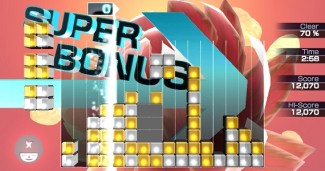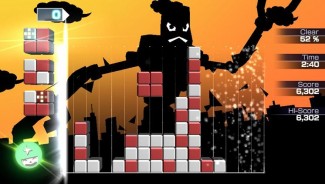The Case of the Golden Idol
LQ: 9.85
Recommended Age: 12+
Skills Used: Focus, Working Memory, Mathematics, Reading

Lumines: Electronic Symphony is a musical puzzle game where players have to rotate and arrange falling blocks in an effort to create solid squares of color. Each 2X2 block is made up of four smaller blocks, each of which is one of two colors. As the blocks fall, music plays, and a line moves across the screen left to right to the beat. Solid squares of color are only eliminated once the line passes over the block, so timing is important. If players fail to arrange colors together and eliminate squares, too many blocks will pile up and the game will end. High scores are recorded, so players can retry to see if they can go further. There is no inappropriate or violent content, no academic skills are needed to play, and the songs that play are not offensive, so the game is suitable for all ages. Due to the difficulty level of the game however, we recommend Lumines: Electronic Symphony to ages 7 and up.
Being efficient and aware of our use of time and effort.
 As the blocks fall from the top of the screen, music plays, while a vertical line moves across the screen erasing solid blocks of color as it passes over them. Set to the music, the line completes each run over the grid in time with the beat. Thus, players have a finite of time to make decisions and place blocks, and must learn to use the tempo of the song to their advantage. Points are scored by erasing big hunks of color from the grid, and if the surrounding blocks fall into place and score again, a bonus is earned. In order to score bonuses, players must stack up blocks and arrange them without clearing them right away. However, if players become greedy and wait too long, the specific block they need to complete the sequence may not show up in time, causing their plan to fall to pieces. In order to be successful, players need to balance drawn out stacking strategies with quick scoring that clears out space to operate.
As the blocks fall from the top of the screen, music plays, while a vertical line moves across the screen erasing solid blocks of color as it passes over them. Set to the music, the line completes each run over the grid in time with the beat. Thus, players have a finite of time to make decisions and place blocks, and must learn to use the tempo of the song to their advantage. Points are scored by erasing big hunks of color from the grid, and if the surrounding blocks fall into place and score again, a bonus is earned. In order to score bonuses, players must stack up blocks and arrange them without clearing them right away. However, if players become greedy and wait too long, the specific block they need to complete the sequence may not show up in time, causing their plan to fall to pieces. In order to be successful, players need to balance drawn out stacking strategies with quick scoring that clears out space to operate.
Furthermore, the game features a "Stop Watch" mode, which tasks players with banking as many points as possible within a set period of time (30, 60, 90, 120 or 300 seconds). Players replay these challenges in an effort to increase their score, learning how to operate faster within the time constraints. There is even a trophy that can be earned in this mode, but it is incredibly hard to acquire, as players must eliminate 30 blocks within the 30 second time limit.
Adapting and adjusting to changing conditions and expectations.
 Due to the fast-paced, hectic nature of the game, it is important for players to be able to make concise decisions and adapt to the ever changing layout of the screen. It takes only one mistake to throw off a carefully planned bonus, so players need to be able to quickly react to mistakes and rethink their strategy on the fly. The game randomly throws out blocks with differently arranged colors, and it is up to the player to quickly rotate them and stack them in a manner that matches up. Doing so requires quick thinking and good reflexes, and inflexible players may struggle making smart snap decisions. Finally, as the game progresses, the blocks fall faster, adding to the frantic nature of the game.
Due to the fast-paced, hectic nature of the game, it is important for players to be able to make concise decisions and adapt to the ever changing layout of the screen. It takes only one mistake to throw off a carefully planned bonus, so players need to be able to quickly react to mistakes and rethink their strategy on the fly. The game randomly throws out blocks with differently arranged colors, and it is up to the player to quickly rotate them and stack them in a manner that matches up. Doing so requires quick thinking and good reflexes, and inflexible players may struggle making smart snap decisions. Finally, as the game progresses, the blocks fall faster, adding to the frantic nature of the game.
On top of all this, periodically the player will receive power-ups. These special blocks offer unique effects that add twists to the gameplay. Chain Blocks, for instance, erase the square they land on and all like-colored blocks connected to it, regardless of whether they are in a solid formation or not. The Shuffle Block randomizes the group of blocks it touches, which can help out jumbled areas but ruin carefully stacked colors. In order to use these power-ups wisely, players need to think differently and act quickly to maximize their effect.
Arranging and coordinating materials in order to complete a task.
 The main task of the game is to successfully manipulate blocks so that like colors are arranged next to one another in order to form solid squares of the same hue. Thus, careful spatial orientation and the ability to quickly place blocks orderly is key to success. The larger they build up their solid blocks of color, the more points players earn once the blocks are erased. Skilled players will be able to create several large groupings of color, so that when one is erased, the surrounding blocks fall into scoring position, earning a "super bonus." If players are unable to spin and manipulate the blocks logically and organize them quickly, they will struggle to create the large groups of color that drive up the score.
The main task of the game is to successfully manipulate blocks so that like colors are arranged next to one another in order to form solid squares of the same hue. Thus, careful spatial orientation and the ability to quickly place blocks orderly is key to success. The larger they build up their solid blocks of color, the more points players earn once the blocks are erased. Skilled players will be able to create several large groupings of color, so that when one is erased, the surrounding blocks fall into scoring position, earning a "super bonus." If players are unable to spin and manipulate the blocks logically and organize them quickly, they will struggle to create the large groups of color that drive up the score.
All membership plans come with full access to our entire suite of tools learning guides, and resources. Here are a few of the ones we think you’ll like the most: